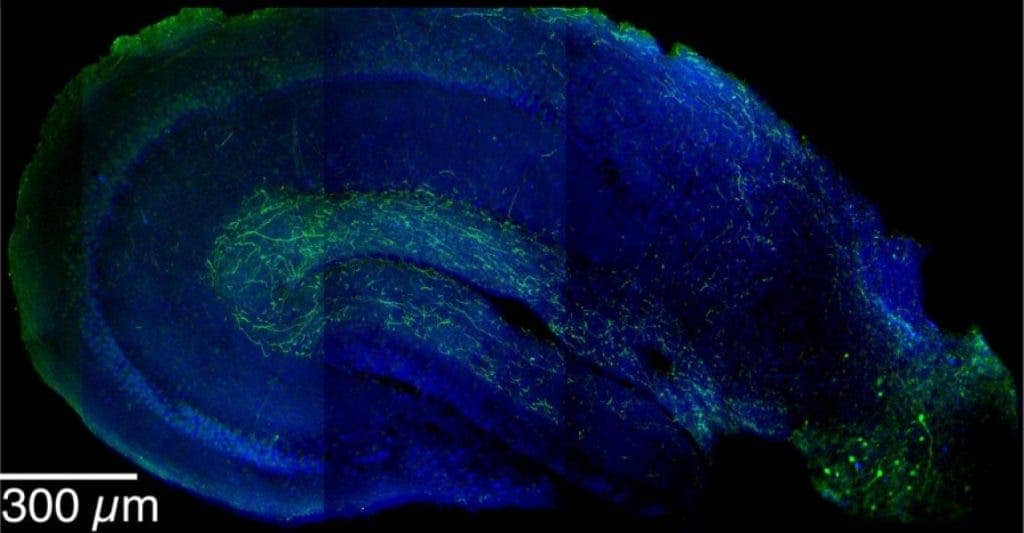Columbia University researchers have successfully identified the cellular network that allows mice to remember which environments are safe and which are dangerous. The study also looks into what happens when these neurons are tampered with, offering insight into how conditions such as PTDS, panic attacks and anxiety disorders can be treated.

This is an image showing LRIP inhibitory neurons (in green) extending from the entorhinal cortex (lower right) into the hippocampus. LRIPs have been found to be part of a sophisticated mechanism that is critical to the formation of contextual memories.
Image via sciencedaily
The brain’s capacity to learn and encode memories are two cornerstone tools for any animal’s survival. Contextual memories (those that form during particular experiences) form the basis for appropriate fear responses in dangerous settings and help avoiding such situations in the future.
Just remembering that a particular setting or series of events ultimately led to danger and estimating whether an environment is safe or poses a threat are two very different things however. Earlier research found that contextual memories form and remain encoded in two separate but highly interconnected brain areas — the hippocampus and the entorhinal cortex — involved in memory and navigation.
Two of the connections between these areas have well documented roles and ways of functioning, but the third such bundle of neurons had scientists puzzling over what ts role actually was.
“Neurons in the entorhinal cortex wind their way into the hippocampus via two distinct routes, or pathways,” explained PhD Jayeeta Basu, first author of the paper.
“It is thought that contextual memories are formed when these two pathways became activated as part of a carefully timed sequence. But a few years ago, scientists discovered a third pathway that linked the two regions whose purpose was unknown.”
There are two “flavors” of neurons; around 80% of them are excitatory meaning they carry signals over long distances in the brain, often across whole brain regions, with the other 20% being inhibitory — they function locally to slow or halt excitatory activity. What was so unusual about the neurons in this recently discovered third pathway was that they acted across a relatively long distance, but were also inhibitory. So scientists called them long-range inhibitory projections, or LRIPs.
This new study aimed to investigate the role LRIPs played in the processes of learning and memory formation. To this end, the team first temporarily inhibited their activity in mice, then placed the animals in a room where they were subjected to a brief electric shock delivered through the floor. When returned to the room 24 hours later, the mice showed signs of fear, indicating that they remembered the electric shock. The scientists concluded that LRIPs weren’t involved in the formation of “fearful memories.”
When placed in a completely different room however, the mice again showed signs of fear, suggesting that their fear of the electric shock generalized from the initial room to a different context. Control-group mice showed signs of fear when placed in the initial chamber but not in the second one, revealing the role of LRIPs in distinguishing between dangerous or benign environments.
Brain imaging techniques and electrical recordings from unaltered mice revealed the role of the connection in much more precise detail. When a stimulus such as sound, light or footshock activates the LRIPs, neurons fire an inhibitory signal from the entorhinal cortex to the hippocampus. This LRIP signal silences a set of inhibitory cells in the hippocampus, allowing other neurons to activate and ultimately generating a memory.
It’s a bit confusing but this series of signals is only a part of a larger and even more convoluted gating mechanism, evidenced by a short 20-millisecnd delay between the activation of the LRIPs and the arrival of inhibitory signals to the hippocampus.
“This brief delay enables the electrical signals to flow into the hippocampus in an elegant, precisely timed sequence, which is ultimately what allows the memory to form and be stored with the appropriate specificity so that it can be recalled accurately,” said senior author Dr. Siegelbaum.
“Without this delay, fearful memories lack specificity and accuracy, preventing the brain from appropriately distinguishing danger from safety.”
“The implications of these findings for the human brain, while preliminary, are intriguing,” said PhD co-author Attila Losonczy.
“The study suggests that any alterations in these pathways activity–particularly a disruption of the timed delay–may contribute to pathological forms of fear response, such as posttraumatic stress, anxiety, or panic disorders.”
The paper, titled “Gating of hippocampal activity, plasticity, and memory by entorhinal cortex long-range inhibition” is available online here.









